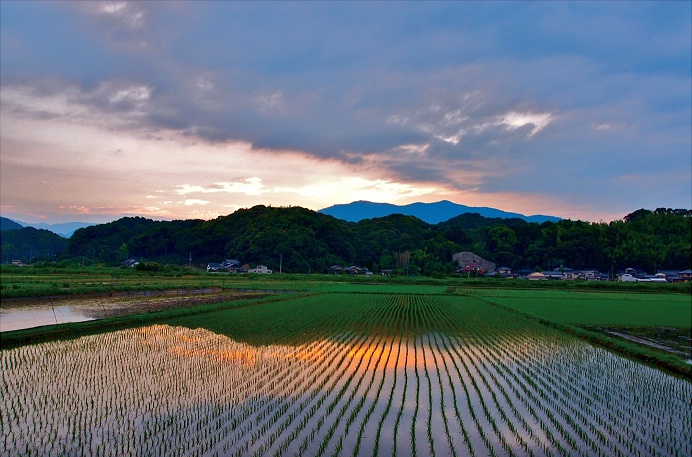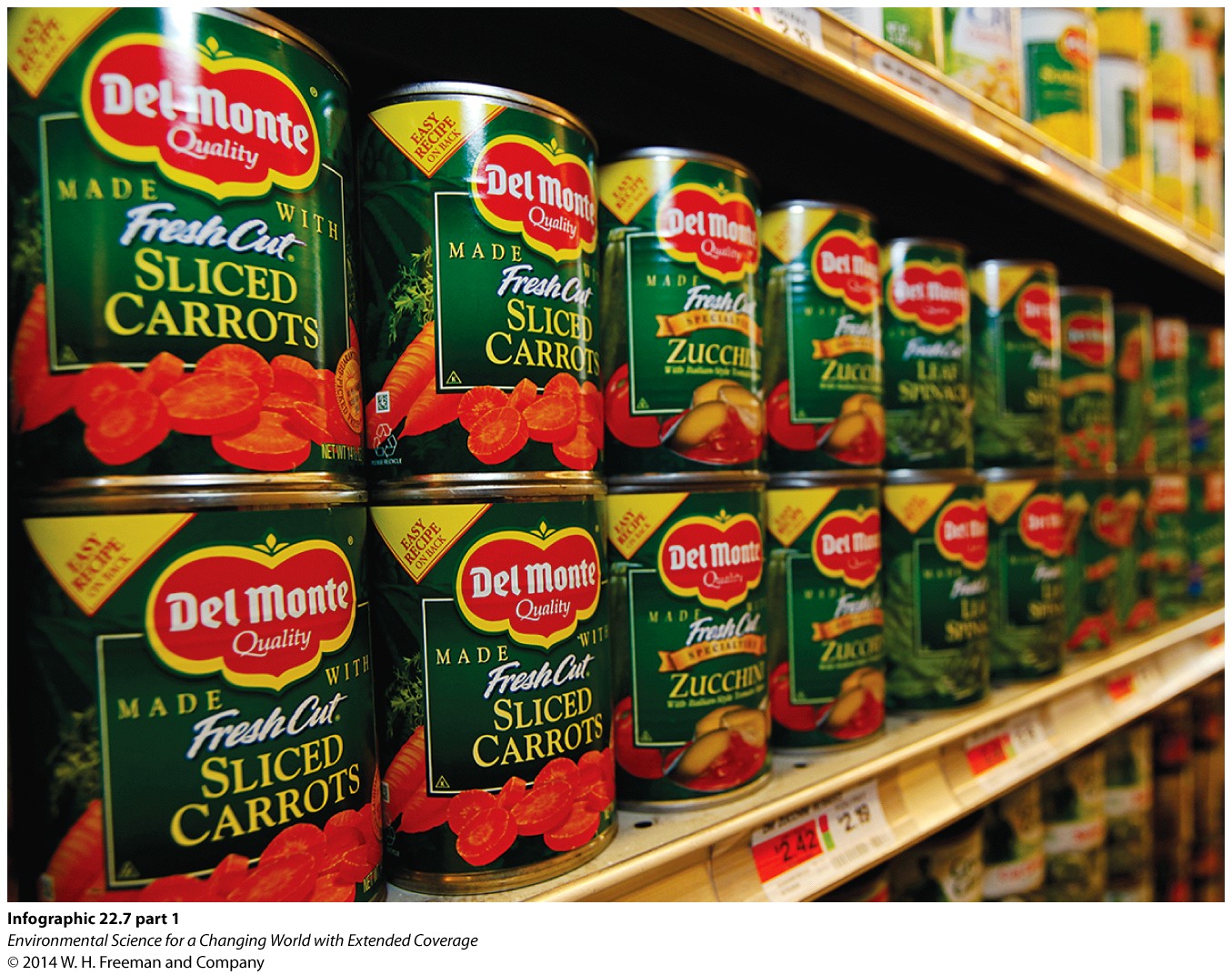Chapter 22. Chapter 22: Agriculture: Raising Crops
What role does the consumer play in helping build a sustainable food system?

Guiding Question 22.4
What role does the consumer play in helping build a sustainable food system?
Why You Should Care
Many small-scale efforts to farm more sustainably are getting attention, especially by environmentalists and agriculturalists. But sustainable and organic farming operations still only represent a small portion of the industry. For agriculture to be truly sustainable, there must be a large-scale “buy-in” by consumers.
Compared to the advertising budgets of food corporations, the means available to small-scale sustainable farmers to promote their products is tiny. Without widespread efforts to educate the general public about the importance of tilling to conserve soil, limiting chemical use, reducing shipping distances, and managing non-renewable energy sources, there is little chance that the average consumer will care about where their food comes from. Two consumer outlets that are supporting sustainable agriculture are farmer's markets and community supported agriculture (CSA). Farmer's markets have been around for millennia, but they've seen a recent upswing in popularity as a small but growing portion of consumers becomes more concerned with eating local, often more naturally and sustainably grown produce and meats. A CSA works like a subscription service between consumers and local farmers. Consumers pay for a “share” in a particular farm's enterprise, and in return get a routine delivery of fresh produce and/or meat. Just the facts that the food is provided in season and from a short distance away makes CSA and farmer's-market food more sustainable, even if the farm's other methods were not. But consumers who take the trouble to go to farmer's markets or pay for CSAs prefer to have their food grown “naturally,” whether or not it would be certifiable as organic, and that usually equates to farming practices that are more sustainable.
How should you vote with your money to promote sustainable agriculture? Buying directly from farmers’ markets or through CSAs is a great way to encourage responsible use of fuel resources and support your local community. There is no doubt that, if all agriculture were converted to being all-natural, the environmental impact of growing our food would be greatly reduced. In truth, it can be difficult and inconvenient to eat with the environment in mind. Locally grown and (especially) organic produce is often more expensive than conventionally grown produce, enough to discourage or even preclude many families from buying them regularly. It's handier to be able to go to the supermarket than to have to wake up early on a weekend to go to a farmer's market. It saves time to buy vegetables pre-washed and pre-cut in a microwavable bag than to wash and steam them yourself. However, the human race only has one planet to live on. Furthermore, many would agree that, if you don't have your health, you don't have anything. Organically and sustainably grown foods are at least as healthy as their industrially grown counterparts, usually more so. Paying a little more for sustainable food now could mean a longer, healthier future for you later.
Question Test Your Vocabulary
Choose the correct term for each of the following definitions:
| Term | Definition |
|---|---|
| mjcHqVVU9gU5N1F9p6bvkAoRl6S8k6FyRWJ06TWY2kCdeRWtmr7RDL/b5wkUzOTD | The amount of carbon released to the atmosphere by a person, company, nation, or activity. |
| vE24/lCepg2mdfoHYtTfkDlaCx2s2rrTXXmge2jHsKD8FQNR7orCXnEc88S2/Ide | Claiming environmental benefits for a product when they are minor or non-existent. |
| cMVVb9QJCittC3ofk+m1JQ6uyqHhXQRPb+1Bcg/lxvUzBYtNXz6G4n3F3+J+2X/z | The distance a food travels from its site of production to the consumer. |

Question 22.1
ispaewha+6QkJdJlbV6bk5ywNNZOp5J56dOMQK5tvWU5GtclEblIXo6u9cfBbMEvUa/WTr1feAHSgfFNU+oC3l/TJ0Kd7MZBuFeqQarLEG98Sa+t3O42d8c3TWpSiw62t8U3czqqXsHTzkHCfgi485zLp5VScsvR0NCuoHG2NNVq7y/1t799oKgoq1OCaBwBuqiGUlg35YnmTwxOM6pGTpTe1kRluJmBsyjLKtK5Y2OM+RT9hpZPjEIulpUpdvKmNCCmbpBPEsQ3muJ8E66RXRTKHUQLoK6gZ1F7NJYa6S8AHqTiwBCpqBM1cnX8KfSa7UpVlVNGAKL5ZZZXa1fa2Hdjdlq+2nHmzUGnUPrN/DngCgOmmuwSRGu9wKCR3RtFNqjJpkVXKa35qaSkc/q+tw==Question 22.2
xIitEfY1X2XqNoU6yjO8CDkW3Plo26GJC4iMdPaWuu5IRaZ9Vl7dAQXCyRz/Nd/fUx09LXg5Zzgt5kAIWlx4tIUCOv36muON3VQH8JFGkueg/9q/OhT7OJkmmtUabbDpnXTbCBMeEzoz0pV4zqa/K/EKl4znnhD6Y/emqqcQhL3QR2tO9mCuOnw5RZMWv7mPyMp/0ULgCqm81y0LrbG0w2vXEU0SrTKC3hILJUPY0t4=Question 22.3
o8klUI6BU4nEI5zbOCj9o8q7+Dxy5AlM/Hmi6OkXlGP9xGWTFJRzyWFZ1GAfHORqFavrx1eXZQF89JYmZn0Q7UhwKLIO4dZbO13dkdWAcpF+QEAGvhPrJzo4Z7fPievxZhUtgHJxkfYky1JjrW5ZXz593i2fh7GNf17yQwPTnYI5tMfy87LfIt/ts3Kufwfto1f95iWA8a0LcLj8ElJc5zmGgtuHER41684DQngDtxiUghWtiSHEPwnvnY7cKdYZM+bHeGrya2mEh1BgG4suk+wXDJa433MMYdflOq/mOQIh8KsoeRGHf1Iw5Ewot4nLSg+ikrovhj0KuJGugkay4L3AN0YR2G8tRK5UTnDzOtQIxR7PkMdYU92HJsDaBlkah11oBQ7RiMmHUbIaST/wk5Wqd358Cez4UHXf19D67UumEYi/Question 22.4
/LMDrhl8ECA5GiLDprcG0VwGZ2Y2U9ASoxZzbSDTQ3iL+cMVHBTcMOUAdXW7+bMKWSaSe4KpVgLIm/B2WVRjlP443qfZbjTxEsONbI9R3kx8y0FoinjXhCRYMaTjaicz6mZMeJcuZwn4HWx/4PlX951MNcRqKk29QOEV1gkoL36EQnbsiwnR/JSr4qOZtnw7JzeYp1XbRFcknSO9ilrcu/MCkBrWAYPjHjgDhLXlTIw=A good criterion for deciding when to buy organic produce is the amount of pesticide residues you would typically find on that produce if you did not buy organic. Use the quiz below to see how well you remember which crops are "clean" (have low residue) and which are "dirty" (have high residue).
Question 22.5
Blueberries (domestic): MbDsu0wKE1bLJ/0fDnN0jrzElDA=
Question 22.6
Spinach: MbDsu0wKE1bLJ/0fDnN0jrzElDA=
Question 22.7
Lettuce: MbDsu0wKE1bLJ/0fDnN0jrzElDA=
Question 22.8
Cabbage: O+XlY+17B1r1YfVT2eHs3DTzz6g=
Question 22.9
Sweet bell peppers: MbDsu0wKE1bLJ/0fDnN0jrzElDA=
Question 22.10
Nectarines (imported): MbDsu0wKE1bLJ/0fDnN0jrzElDA=
Question 22.11
Grapefruit: O+XlY+17B1r1YfVT2eHs3DTzz6g=
Question 22.12
Celery: MbDsu0wKE1bLJ/0fDnN0jrzElDA=
Question 22.13
Strawberries: MbDsu0wKE1bLJ/0fDnN0jrzElDA=
Question 22.14
Onions: O+XlY+17B1r1YfVT2eHs3DTzz6g=
Question 22.15
Grapes: MbDsu0wKE1bLJ/0fDnN0jrzElDA=
Question 22.16
Kiwi: O+XlY+17B1r1YfVT2eHs3DTzz6g=
Question 22.17
Cucumbers: MbDsu0wKE1bLJ/0fDnN0jrzElDA=
Question 22.18
Asparagus: O+XlY+17B1r1YfVT2eHs3DTzz6g=
Question 22.19
Mushrooms: O+XlY+17B1r1YfVT2eHs3DTzz6g=
Question 22.20
Potatoes: MbDsu0wKE1bLJ/0fDnN0jrzElDA=
Question 22.21
Sweet corn: O+XlY+17B1r1YfVT2eHs3DTzz6g=
Question 22.22
Pineapples: O+XlY+17B1r1YfVT2eHs3DTzz6g=
Question 22.23
Peaches: MbDsu0wKE1bLJ/0fDnN0jrzElDA=
Question 22.24
Avocado: O+XlY+17B1r1YfVT2eHs3DTzz6g=
Question 22.25
Apples: MbDsu0wKE1bLJ/0fDnN0jrzElDA=
Question 22.26
Mangoes: O+XlY+17B1r1YfVT2eHs3DTzz6g=
Question 22.27
Eggplant: O+XlY+17B1r1YfVT2eHs3DTzz6g=
Question 22.28
Cantaloupe (domestic): O+XlY+17B1r1YfVT2eHs3DTzz6g=
Question 22.29
Sweet potatoes: O+XlY+17B1r1YfVT2eHs3DTzz6g=
Question 22.30
Sweet peas: O+XlY+17B1r1YfVT2eHs3DTzz6g=
Question 22.31
Watermelon: O+XlY+17B1r1YfVT2eHs3DTzz6g=